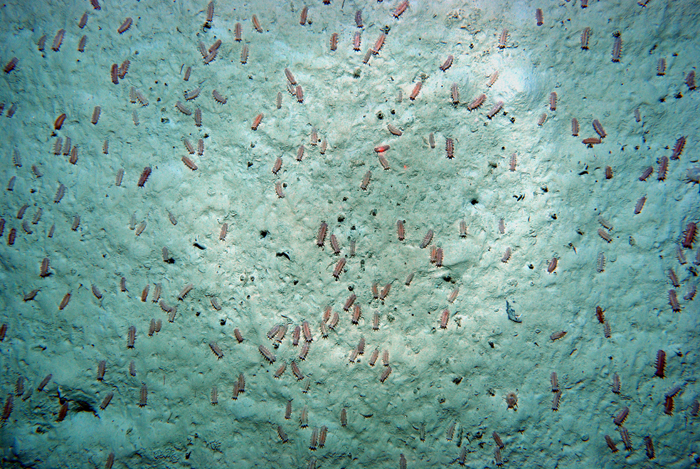|
Page 2/2 - Posted February 13, 2009
Tools and techniquesThe team will use a variety of tools on board the vessel to collect the samples needed for experiments and analyses. The transect includes five stations, or sampling sites, where the vessel holds position for the scientists to deploy their instruments. One of the more impressively named tools is something called a megacore, a coring device capable of extracting 12 separate, shallow cores at one time. A frame holds a rack of trigger-controlled coring tubes mounted on a weighted slide. When the base of the frame hits bottom, the weighted slide drives the core tubes down into the sediment. Project Blogs
“Some samples are so pristine we find organisms grazing on top of the sediment or boring tunnels through the middle sections,” Arezzo wrote. DeMaster said the cores offer the scientists an “extremely good” look at the interface between the sediment and water. They can use the samples to learn how organic matter is cycled and degraded. The deployment and recovery of the megacore takes a couple of hours, depending on the roughness of the seas. “When the ship is heaving 10 or 12 feet during a pretty good blow, the sediment-water interfaces aren’t as pristine as they are during winter conditions when sea ice dampens the wave field,” DeMaster said. Other methods to collect samples include sediment traps, trawls and other coring tools, such as a box core that takes a 50- x 50- x 50-centimeter cube of mud to measure benthic biomass and diversity. This cruise will also recover two time-lapse cameras that have been operating on the seafloor at both ends of the transect since the winter cruise. Some measurements occur onboard the ship, but most of the work involves preserving the samples for later study. Smith said the team will certainly study the photographs from the cameras as soon as possible. “We’ll be too excited to see what happens over time to let those sit around too long,” he said. Another analysis that occurs at sea involves using a special dating technique to determine the nature of seafloor organic matter deposition, which helps the scientists determine feeding strategies. One marker is thorium-234, a naturally occurring radioisotope with a short 24-day half-life. The presence of thorium-234 atoms in a sample indicates it recently fell to the seafloor because of the rapid radioactive decay. DeMaster will also use carbon-14 data to track the age of the seabed organic material. Some of the bottom-dwellers, he noted, are fussy and only choose from the surface floc layer of freshest food, while others take in bigger gulps of bulk organic material from the upper sediment column. The latter organisms have special digestive enzymes that preferentially digest only the fresh organic material. “For being dumb animals, they are quite proficient at getting the energy-rich fresh plankton that’s settling on the seabed, either by extracting it from the upper millimeter or preferentially digesting it in their gut,” DeMaster said. The scientists collect literally hundreds of organisms for their experiments, many of them new species, according to Smith. “One of the most important, abundant species in Antarctica was just described a month ago,” he said. The new species, Aurospio foodbancsia, a polychaete worm, was just described in the journal Marine Ecology. “It’s remarkable that you can go out and collect specimens, and the most abundant organism in your samples is new to science and distributed over a large area of the Antarctic continental shelf,” Smith said. Winners and losersBut how will Aurospio foodbancsia and the hundreds of other types of critters on the seafloor fare in the coming years? Smith said he sees the impending changes to the peninsula climate as a serious threat to many of today’s species. As conditions warm, he said, the less extreme environment will welcome invasive species, particularly from South America. “I think most of the endemic Antarctic fauna will be losers,” he said. “It’s a system that’s highly structured by sea ice and by the very cold temperatures that result from sea ice formation and somewhat higher salinity.” He said one aggressive invading predator, a stone crab, has been already documented at deeper depths off Antarctica, and it may eventually move up onto the shelf. The bottom-dwelling critters evolved without such a predator and they would likely be vulnerable to predation. “I see a lot of doom and gloom for the Antarctic fauna, quite frankly,” Smith said. DeMaster noted that some species that are able to adapt to changes in diet, such as switching to a common type of phytoplankton called diatoms, will be favored. “There will be some success and some failures in terms of competition for the nutrition that makes it to the seabed. Some may adapt. We don’t know if some of these animals may successfully transfer to freshly fallen diatom organic matter versus ice algae as a source of nutrition.” But the scientists also worry about the fate of a terrestrial species — humans. DeMaster said that the same climate changes along the peninsula, West Antarctica and Greenland are speeding the discharge of ice into the oceans. Some estimates say sea level could be up by a meter at century’s end. “A sea level rise [like] that is considerable when you consider 50 percent of the world’s population lives within 100 kilometers of the coast,” DeMaster said. NSF-funded research in this story: Craig Smith, University of Hawaii, Award No. 0636806 |



For USAP Participants |
For The Public |
For Researchers and EducatorsContact UsU.S. National Science FoundationOffice of Polar Programs Geosciences Directorate 2415 Eisenhower Avenue, Suite W7100 Alexandria, VA 22314 Sign up for the NSF Office of Polar Programs newsletter and events. Feedback Form |


